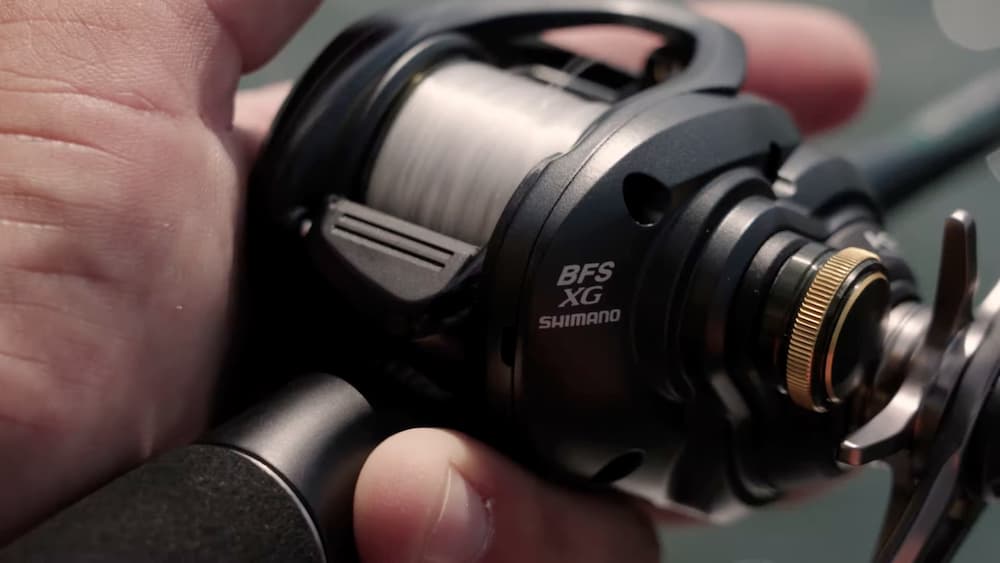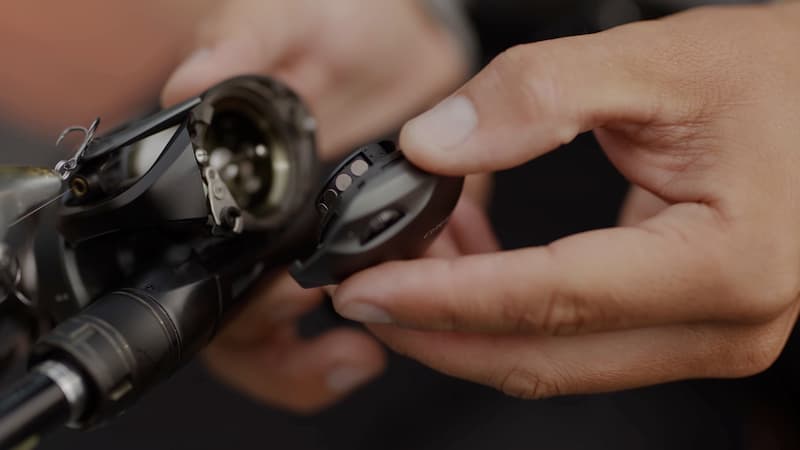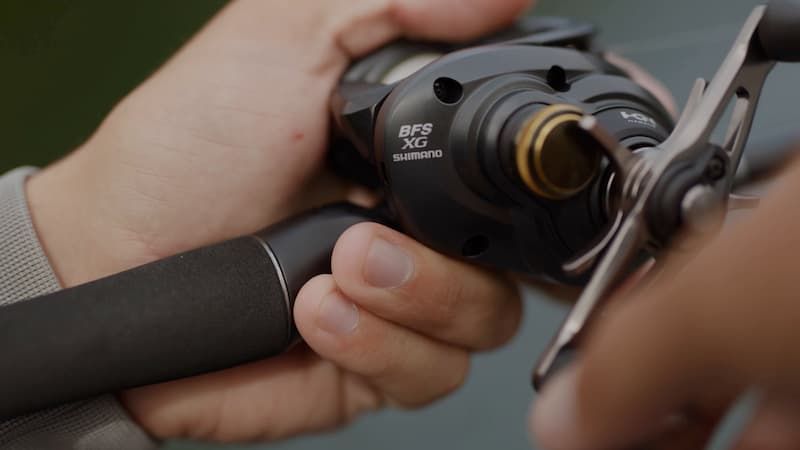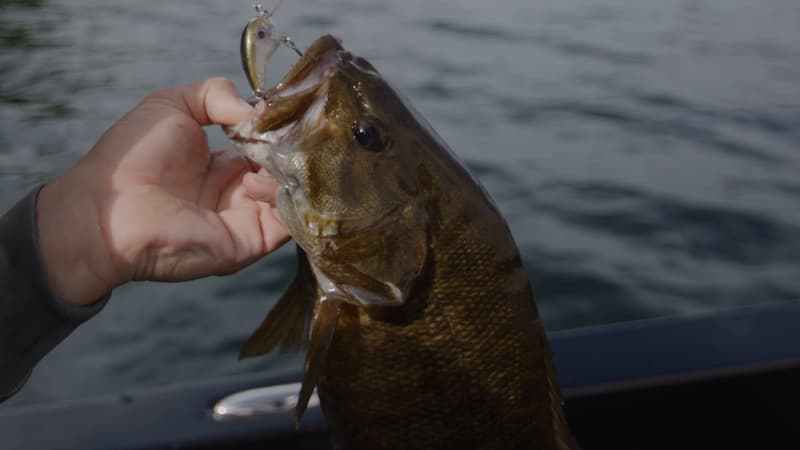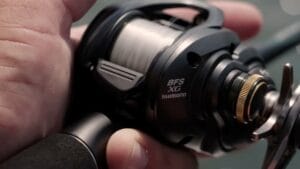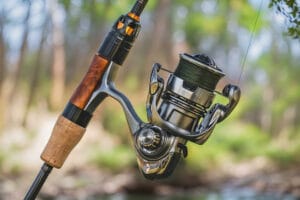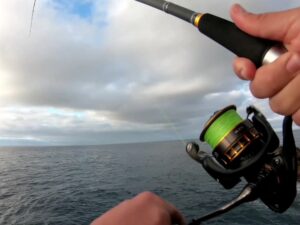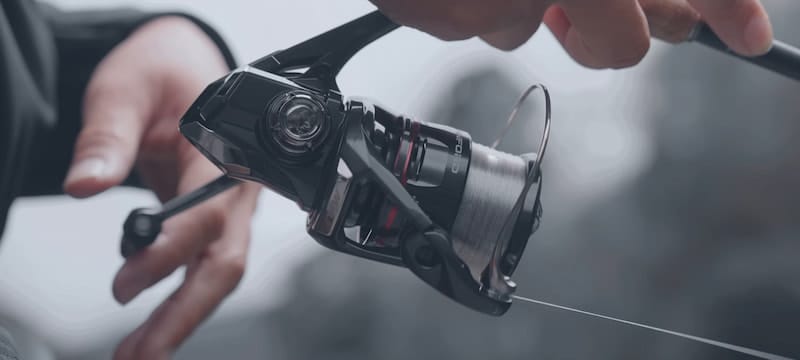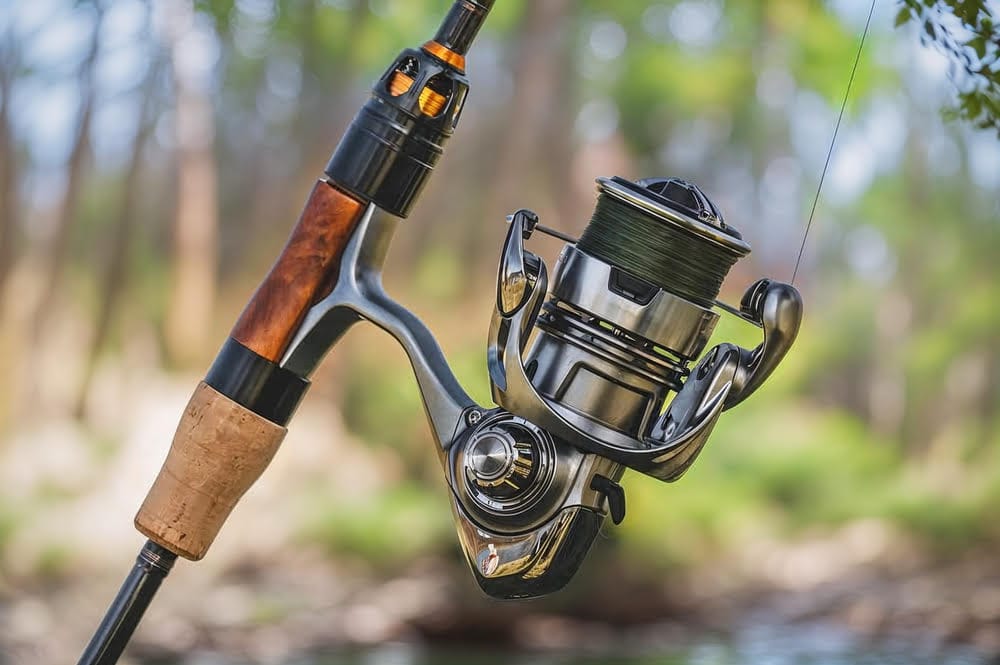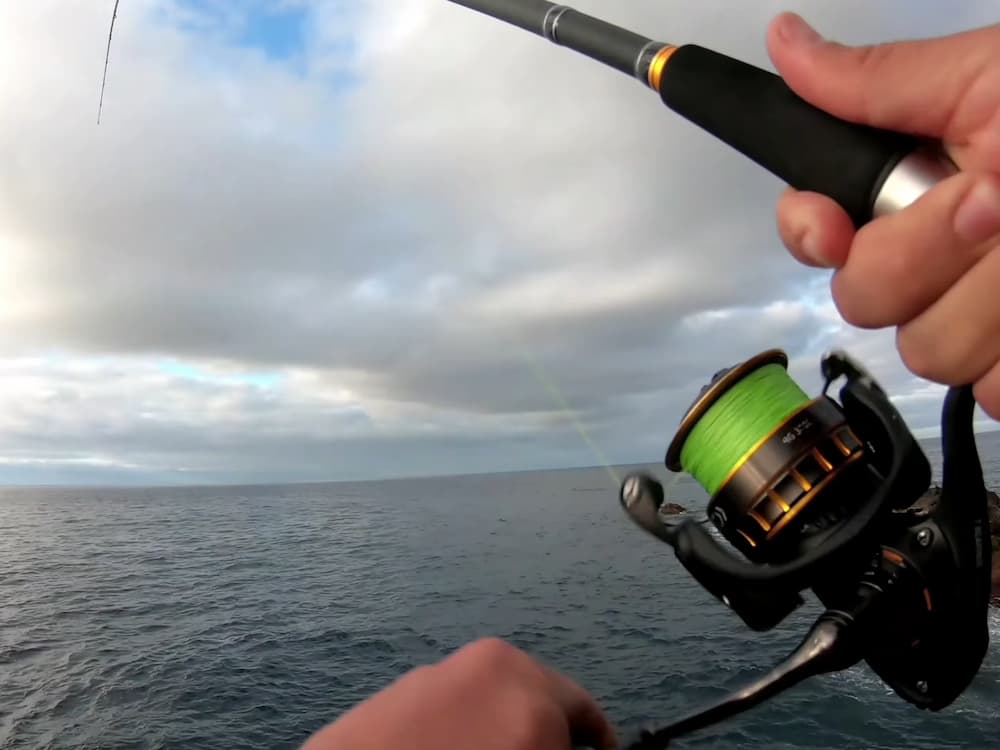Performance Analysis
Casting
The most important attribute of any BFS reel is its casting performance with lightweight lures, and this is where the Curado BFS truly shines. The shallow, lightweight S3D spool (just 8.8 grams) represents a dramatic departure from standard baitcasting spools, requiring significantly less energy to initiate rotation. This translates to the ability to cast lures as light as 1/16 oz with practice, though I found the sweet spot to be in the 1/8-1/4 oz range for both distance and control.
At the heart of the Curado BFS’s casting prowess is Shimano’s Finesse Tune Brake (FTB) system, which differs significantly from traditional SVS or brake weight systems. The FTB system moves the braking mechanism from the spool itself to the palming side plate, allowing for an even lighter spool while maintaining control throughout the cast. This system works dynamically, applying braking force when it’s needed early in the cast and then reducing it as spool speed stabilizes.
On the water at Smith Lake, this translated to consistent 40+ yard casts with 1/8 oz Ned rigs even in light crosswinds—distances I simply couldn’t match with a comparable spinning setup. More impressive than raw distance was the accuracy; the direct contact of thumb to spool allowed for precise placement around laydowns and rock structures where spotted bass often held tight.
The braking system is adjusted via a small external dial with settings from 0-10. Through extensive testing, I found that settings between 3-5 offered the best balance of distance and control for most lighter presentations. With lures under 1/8 oz, settings of 5-7 were necessary to prevent backlashes, while heavier lures in the 1/4-3/8 oz range performed well with settings of 1-3.
The only downside to the brake adjustment system is the dial itself—it’s small, tight, and requires a fingernail to adjust. When fishing in cold conditions with gloves, this became particularly cumbersome. I would have preferred a larger, more tactile brake adjustment dial similar to those found on Shimano’s DC reels.
Super Free Spool technology further enhances casting by reducing friction on the spool shaft during rotation. This was particularly noticeable when making repeated casts with ultra-light lures, as the spool maintained consistent performance cast after cast without developing the “stickiness” that can sometimes plague budget-oriented BFS-style reels after extended use.
Retrieve
Equipped with Shimano’s X-Ship and MicroModule gearing system, the Curado BFS provides a remarkably smooth retrieve experience that belies its specialized nature. Many specialty reels compromise on retrieve quality to achieve their primary function, but the Curado BFS maintains the same smooth, refined feel that Curado users have come to expect.
The 8.2:1 high gear ratio (with 32 inches of line recovery per handle turn) proved ideal for the finesse techniques most suited to this reel. When fishing small swimbaits in Lake Guntersville’s expansive grassbeds, the high-speed retrieve allowed me to quickly pick up slack and maintain constant tension when a fish suddenly changed direction—a common occurrence when dealing with the lake’s aggressive largemouth population.
Shimano’s MicroModule gear system features smaller, more precisely formed gear teeth that mesh together with minimal noise and friction. This was particularly apparent when slow-rolling lightweight presentations along deep ledges at Smith Lake, where the smooth retrieve helped maintain the subtle action that proved crucial for triggering bites from pressured spotted bass.
While the retrieve doesn’t match the absolute silky smoothness of Shimano’s higher-end offerings like Bantam or Metanium, it’s impressively close—especially considering the price point. After eight months of heavy use, including several dunks in water and exposure to sand and grit, the gears showed no signs of developing play or roughness, a testament to Shimano’s engineering and quality control.
The 7+1 bearing system contributes to the overall smoothness, with strategically placed bearings supporting crucial contact points. While more bearings don’t necessarily translate to better performance, the placement and quality of these bearings clearly enhance the overall user experience and durability.
Drag
One of the most distinctive features of the Curado BFS—and one that many anglers will either love or hate—is its audible drag clicker. Reminiscent of a spinning reel’s sound, this feature provides excellent feedback when a fish is pulling drag. During a memorable session at Lake Guntersville when sight-fishing for bedding bass in spring, this audio feedback proved invaluable, alerting me to subtle takes when my focus was divided between watching the bed and managing boat position.
The maximum drag rating of 8 pounds is considerably lower than standard Curado models (which typically offer 11-12 pounds), a concession to the finesse applications this reel is designed for. This lighter drag is perfectly matched to the lighter line and hooks typically used with finesse presentations. However, it does require an adjustment in fighting technique for anglers accustomed to setting hooks with a locked-down drag.
During my testing, I found that setting the drag to approximately 25-30% of line strength (about 2-2.5 pounds of pressure when using 8-pound test) provided the optimal balance between hook-setting power and fighting capability. This setting allows enough resistance for solid hooksets while providing adequate cushion for the sudden runs and head shakes that big bass are known for.
When I hooked a 6-pound largemouth along a riprap bank at Lake Guntersville in late fall, the Curado BFS’s drag performed flawlessly, smoothly releasing line when needed but maintaining consistent pressure throughout the fight. Even when the fish made a powerful dive toward a submerged tree, the drag remained smooth and responsive, allowing me to tire the fish rather than attempting to horse it away from cover.
The Duracross drag washers provide exceptional smoothness and consistency, even during extended runs. Unlike felt washers that can compress and become inconsistent when wet, the Duracross material maintained the same pressure from the beginning of a fish’s run to the end, an important consideration when fighting larger fish on lighter tackle.
For most bass fishing applications, the 8-pound maximum drag proved more than sufficient. However, when fishing around heavy cover, I occasionally found myself wanting a bit more stopping power. In these situations, lightly thumbing the spool provided the additional resistance needed without compromising the drag system’s smoothness.
Ergonomics
The overall ergonomics of the Curado BFS reflect Shimano’s decades of experience in creating user-friendly baitcasting reels. At 6.2 ounces, it strikes an excellent balance—light enough to prevent fatigue during all-day fishing sessions but substantial enough to provide the necessary stability and durability expected from a Curado.
The reel’s compact profile and low-sitting spool allow for comfortable palming—a critical consideration when making repeated casts with finesse applications. The double paddle handle provides good leverage for both power and finesse retrieves, with the paddle knobs offering secure grip even in wet conditions.
During summer on Guntersville when temperatures soared into the 90s, I appreciated how the Hagane body dissipated heat effectively, never becoming uncomfortably warm to hold even after hours of continuous use. Likewise, during winter fishing at Smith Lake, the metal components didn’t become painfully cold to touch as some reels can.
The only ergonomic weakness I encountered was the aforementioned small magnetic brake adjustment dial, which proved difficult to manipulate with cold, wet hands or while wearing gloves. Additionally, the numbers on this dial are small and difficult to read in low light conditions, making quick adjustments challenging at dawn or dusk.
When paired with an appropriate BFS-specific rod (mine was the Dobyns Sierra Ultra Finesse 722SF), the overall balance of the system was exceptional. The light weight of the reel complemented the lighter-action rod perfectly, creating a setup that could be fished all day without fatigue while still providing the backbone needed to control and land quality bass.
Ned Rig Mastery
One particular technique where the Curado BFS absolutely excelled was Ned rig fishing—an approach that has revolutionized finesse bass fishing but traditionally been dominated by spinning gear. With 1/8 oz Z-Man Finesse TRD setups, the Curado BFS allowed me to achieve casting distances comparable to spinning gear while maintaining the superior line control and hookset leverage of a baitcaster.
During a particularly tough mid-summer day at Lake Guntersville, I located a school of quality largemouth holding on a subtle creek channel edge in 12 feet of water. These fish were completely ignoring traditional power presentations but would reluctantly bite a Ned rig if presented precisely. With the Curado BFS, I could make repeated accurate casts to the sweet spot, feeling the subtle tick as bass picked up the bait on the fall.
The 8.2:1 gear ratio proved perfect for this application, allowing me to quickly take up slack when a fish bit and maintain direct contact throughout the fight. The reel’s superior line management prevented the annoying loops and twists that often plague spinning setups when fishing this technique, especially with braid-to-fluorocarbon leader combinations.
Most impressively, the direct line control allowed me to steer hooked fish away from nearby brush piles much more effectively than I could have with spinning gear. This advantage became crystal clear when I connected with a solid 5.2-pound largemouth that immediately dove for a nearby brush pile. The ability to apply side pressure through the baitcasting setup allowed me to turn the fish’s head and guide it away from the cover—something that would have been much more challenging with the less direct connection of a spinning setup.
This experience crystallized for me just how valuable this reel can be in an angler’s arsenal. While the Ned rig has become a go-to technique for many anglers, fishing it with a properly designed BFS setup elevates the presentation to new levels of control and effectiveness. This could represent a significant competitive advantage when targeting pressured fish in clear water situations.

